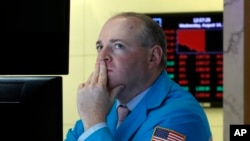ຕະຫລາດຮຸ້ນຢູ່ໃນຍີ່ປຸ່ນ ໄດ້ຕົກລາຄາ ໃນວັນພະຫັດມື້ນີ້ ແຕ່ກໍບໍ່ໄດ້ຕົກວູບລົງ ຫລາຍດັ່ງທີ່ເຫັນຢູ່ໃນຕະຫລາດຂອງສະຫະລັດນຶ່ງມື້ກ່ອນ ທີ່ໄດ້ກະຈາຍຄວາມຢ້ານກົວ ໄປທົ່ວວ່າຈະມີສະພາບເສດຖະກິດຖົດຖອຍເກີດຂຶ້ນ.
ດັດຊະນີນິກເກຂອງໂຕກຽວໃນຕອນປິດຕະຫຼາດ ໄດ້ຕົກລາຄາແມ່ນ 1.2% ໃນວັນພະຫັດມື້ນີ້ ໃນຂະນະທີ່ຢູ່ບ່ອນອື່ນໆໃນເອເຊຍ, ດັດຊະນີປະສົມໃນຕະຫຼາດ ຊຽງໄຮ້ຂອງຈີນ ແລະໃນຕະຫລາດຮັງເຊັງຂອງຮົງກົງ ກໍຕົກລາຄາ ປານໆກັນ ໃນຕອນບ່າຍໆກ່ອນປິດຕະຫຼາດ.
ອະນາຄົດຂອງຕະຫລາດຮຸ້ນສະຫະລັດ ມີທ່າທີວ່າຈະດີຂຶ້ນໜ້ອຍນຶ່ງໃນວັນພະຫັດມື້ນີ້ ຊຶ່ງເປັນການຟື້ນໂຕຄືນ ຈາກການຊື້ຂາຍຂອງຕະຫລາດຮຸ້ນໃນວັນພຸດວານນີ້ທີ່ໄດ້ສົ່ງຜົນເຮັດໃຫ້ຮຸ້ນອຸດສາຫະກຳດາວໂຈນສະເລ່ຍຫຼື Dow Jones Industrial Average, ຮຸ້ນສະແຕນດາດ ແອນ ພົວສ໌ ຫຼື S and P 500 ແລະຮຸ້ນແນັສແດັກ (Nasdaq) ລ້ວນແຕ່ຫລຸດລາຄາລົງ 3 ເປີເຊັນໝົດ.
ດັດຊະນີຮຸ້ນຂອງຢູໂຣບ ກໍຕົກວູບລົງຢ່າງໜັກເຊັ່ນກັນ.
ພວກນັກວິເຄາະ ໄດ້ຊີ້ໄປໃສ່ຂໍ້ມູນດ້ານເສດຖະກິດທີ່ອ່ອນແອຂອງເຢຍຣະມັນ ແລະຂອງຈີນວ່າ ເປັນສັນຍານເຕືອນໃຫ້ຮູ້ວ່າ ອາດມີການຂະຫຍາຍໂຕຊ້າລົງ ຂອງເສດຖະກິດໂລກ. ແຕ່ວ່າສິ່ງທີ່ສຳຄັນທີ່ສຸດ ພວກນັກວິເຄາະບອກວ່າເປັນຍ້ອນ ສິ່ງທີ່ເອີ້ນວ່າ ການພິກຜັນຂອງຜົນໄດ້ຮັບສຳລັບອັດຕາດອກເບ້ຍຂອງພັນທະບັດຂອງທະນາຄານກາງສະຫະລັດສຳລັບໄລຍະ 2 ແລະ 10 ປີ. ຕາມ ປົກກະຕິແລ້ວ, ອັດຕາດອກເບ້ຍຂອງພັນທະບັດລັດຖະບານ ທີ່ຖືໄວ້ໃນໄລຍະຍາວແມ່ນສູງກວ່າ ອັດຕາດອກເບ້ຍຂອງພັນທະບັດທີ່ຖືໄວ້ໃນໄລຍະສັ້ນກວ່າ.
ແຕ່ວ່າ ການພິກຜັນໃນອັດຕາດອກເບ້ຍໄດ້ມີຜົນກະທົບໃນວັນພຸດວານນີ້ ແລະ ພວກນັກວິເຄາະໄດ້ເຫັນວ່າມັນເປັນຮ່ອງຮອຍສະແດງໃຫ້ຮູ້ວ່າ ພວກນັກລົງທຶນມີຄວາມເປັນຫ່ວງກ່ຽວກັບສະພາບການຂອງເສດຖະກິດສະຫະລັດໃນເວລານີ້.
ມັນເປັນຄັ້ງທຳອິດທີ່ມີການພິກຜັນຂອງອັດຕາດອກເບ້ຍເຊັ່ນນັ້ນໄດ້ເກີດຂຶ້ນ ນັບແຕ່ປີ 2007 ເປັນຕົ້ນມາ, ຢູ່ໃນຕອນເລີ້ມຕົ້ນຂອງສະພາບເສດຖະກິດຖົດຖອຍຂອງສະຫະລັດ ຊຶ່ງເປັນການຊຸດໂຊມຂອງສະພາບເສດຖະກິດສະຫະລັດທີ່ຮ້າຍແຮງທີ່ສຸດນັບແຕ່ມີວິກິດການທາງເສດຖະກິດໃຫຍ່ໃນຊຸມປີ 1930 ເປັນຕົ້ນມາ.
ກຳມະກອນສະຫະລັດຫລາຍລ້ານຄົນ ແມ່ນຕົກງານຢູ່ໃນໄລຍະທີ່ມີສະພາບເສດຖະກິດຖົດຖອຍໃນທົດສະວັດກ່ອນ ພ້ອມທັງເສຍເຮືອນຊານຂອງເຂົາເຈົ້າ ເມື່ອເຂົາເຈົ້າບໍ່ມີເງິນພຽງພໍ ສຳລັບຈ່າຍເງິນກູ້ໃນແຕ່ລະເດືອນ.
ອ່ານຂ່າວນີ້ເພີ້ມເປັນພາສາອັງກິດຢູ່ຂ້າງລຸ່ມນີ້
Stock markets in Japan fell Thursday, but not as drastically as the plummets experienced by U.S. markets a day earlier that amplified recession fears.
Tokyo's Nikkei index closed down 1.2% Thursday while elsewhere in Asia, China's Shanghai Composite Index and Hong Kong's Hang Seng were about even in late trading.
U.S. market futures pointed to slight gains Thursday, rebounding from Wednesday's trading that sent the Dow Jones Industrial Average, Standard and Poors 500 and Nasdaq all down 3%.
Major European indexes also fell sharply Wednesday. Analysts pointed to weak German and Chinese economic data as warning signs of a possible world economic slowdown.
Yield-curve inversion
But most importantly, the analysts pointed to a so-called yield curve inversion for interest rates on two- and 10-year U.S. Treasury notes.
Typically, interest rates on government bonds held for a long time are higher than those held for shorter periods.
But the reverse was in effect Wednesday, and the analysts see it as a sign that investors have worries about the immediate state of the U.S. economy.
It was the first time such an interest rate inversion had occurred since 2007, at the start of the U.S. recession that was the country's worst economic downturn since the Great Depression of the 1930s.
Millions of U.S. workers lost their jobs in the recession a decade ago, as well as their homes, when they no longer had enough money to make monthly loan payments.
The bond interest rate inversion has preceded the last nine U.S. recessions over the last six decades, although the barometer is not a perfect indicator. No recession occurred in 1966, even though there had been an inversion.
China, Germany weaken
Meanwhile, China said its factory production was the weakest in 17 years, while Germany, Europe's most powerful economic engine, said its economic output shrank in the April-to-June period by one-tenth of a percentage point.
The negative economic indicators could push central banks around the world to cut their key interest rates, following U.S. Federal Reserve policymakers who last month trimmed the key U.S. benchmark rate by one-quarter of a percentage point.
U.S. President Donald Trump blamed Wednesday's economic news on the fed, tweeting:
Trump, who has touted a robust U.S. economy as a key reason voters should re-elect him in 2020, has frequently criticized the independent Federal Reserve Board for not cutting interest rates fast enough.





